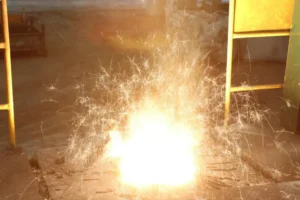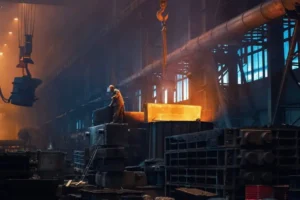Sử dụng các khuyết tật đúc để “kỹ sư đảo ngược” melting problems is a highly effective quality diagnosis method. While induction furnaces (especially Medium Frequency furnaces) offer high melting efficiency and uniform composition, improper operational control can easily introduce defects at the source.
1. độ xốp / Gas Holes
Manifestation: Pinholes on machined surfaces, subcutaneous blowholes, or round/oval cavities inside the casting.
Traceback to Induction Furnace Operations:
- Improper Charge Management (Most Common):
- Wet/Oily/Rusty Charge: Charge materials (especially scrap steel and returns) loaded without sufficient drying or rust removal. The rapid heating of the induction furnace causes moisture and oil to instantly vaporize and decompose into Hydrogen (H) and Nitrogen (N), which are then absorbed by the molten metal.
- Excessive Chips/Light Scrap: Using too many loose cutting chips (un-briquetted). Their high surface-area-to-volume ratio means they adsorb significant amounts of oil and oxides, leading to a surge in gas content.
- Uncontrolled Melting Temperature & Time:
- “Stewing at High Heat”: Holding the molten iron at high temperatures (ví dụ., above 1500°C) for too long. The electromagnetic stirring of the induction furnace constantly exposes fresh metal to the atmosphere, causing gas absorption (especially H and N) to rise exponentially.
- Cold Start without Sintering: After relining or a long shutdown, failing to dry and sinter the furnace properly allows moisture from the refractory material to enter the first batch of molten metal.
- Lining Material Issues:
- Excessive Boric Acid: In acidic linings, if the ratio of boric acid is too high, it may decompose at high temperatures, introducing moisture or gases.
2. Slag Inclusions
Manifestation: Irregular non-metallic substances on the surface or inside the casting, usually dark or black in color, often accompanied by voids.
Traceback to Induction Furnace Operations:
- Incomplete Slag Removal (Khử xỉ):
- Lack of Coagulant/Late Deslagging: Failing to use a slag coagulant (perlite/remover) or skimming slag too late, causing fine fragmented slag to be poured into the ladle.
- Excessive Induction Stirring: If the furnace runs at full power during the late melting stage, the vigorous electromagnetic stirring can pull floating slag down into the melt (entrainment), creating suspended inclusions that are difficult to float out.
- Xói mòn lớp lót (Thể vùi nội sinh):
- Physical Impact: Heavy charge materials hitting the furnace bottom or walls during loading, causing refractory material to peel off and mix into the melt.
- Chemical Erosion: Excessively high melting temperatures or uncontrolled slag basicity (ví dụ., melting high-manganese steel in an acidic lining) causes chemical attack on the lining, introducing reaction products into the melt.
- Sintered Layer Cracking: In intermittent production, rapid heating and cooling cause micro-cracks in the lining. Molten iron penetrates these cracks during the next heat, peeling off refractory particles.
3. Chemical Composition Segregation or Deviation
Manifestation: Inconsistent hardness across the casting, abnormal microstructure, or major elements exceeding or falling short of specifications.
Traceback to Induction Furnace Operations:
- Incorrect Charging Sequence (Element Burn-off):
- Early Addition of Oxidizable Alloys: Adding Ferrosilicon (Trả lời) or Ferromanganese (FeMn) too early or at the furnace bottom causes them to oxidize at high temperatures, resulting in low recovery rates and off-spec composition.
- Poor Recarburizer Absorption: Adding recarburizer too late (after the metal is fully melted) or onto the slag surface leads to very low and unstable absorption rates, causing fluctuations in Carbon Equivalent (CE).
- “Bridging” Phenomenon:
- Material Hang-ups: Large charge pieces getting stuck at the furnace throat while the metal below has melted and superheated. The charge above doesn’t fall. This leads to severe gas absorption in the superheated bottom melt, uneven composition, and oxidation/splashing when operators force the bridge to collapse.
- Lack of Settling Time:
- Although induction furnaces have auto-stirring, immediate tapping after adding heavy/noble alloys without allowing sufficient time for diffusion can lead to local segregation.
4. Cracks and Brittle Fractures
Manifestation: Hot tears (intergranular cracks, oxidized fracture surface) or Cold cracks (transgranular fracture, metallic luster).
Traceback to Induction Furnace Operations:
- Accumulation of Trace Impurities:
- Uncontrolled Recycling: Unlimited cycling of internal returns to cut costs leads to the accumulation of Sulfur (S), Phốt pho (P), and trace elements like Lead (Pb) and Tin (Sn). This significantly increases the tendency for hot tearing and brittleness.
- Coarse Grains due to Overheating:
- Excessive Melting Temperature: If the power isn’t cut in time and the metal is severely overheated, the hereditary nuclei in the melt are destroyed. This results in abnormally coarse grains after solidification, drastically reducing mechanical properties and causing cracks.
Bản tóm tắt: Operational Improvements for Induction Furnaces
To minimize the defects mentioned above, Một “health check” of furnace operations is recommended:
- “Cold before Hot, Small before Big”: Strictly control the charging sequence. Add recarburizer with cold charge at the bottom; use small scraps at the bottom and large scraps in the middle to prevent bridging; add oxidizable alloys (Và, Mn) late in the melting process.
- Avoid “Slow Boiling at High Temp”: Once the iron reaches tapping temperature, adjust and tap immediately. Minimize the time the molten iron stays at high temperatures to prevent gas pickup and oxidation.
- Power Control: Use full power for melting, but reduce power during refining/holding. Avoid high-power stirring during slag skimming to prevent slag entrainment.
- Charge Purification: Even for induction furnaces, charge cleanliness is vital. Heavily oiled or rusted scrap must be pre-treated (shot blasting or baking/drying).
Next Step:
If you have specific photos of defects or a metallographic report available, would you like to upload or describe them? I can help you pinpoint exactly which stage of the melting process (ví dụ., is it a deslagging issue or a deoxidation issue) needs adjustment.







